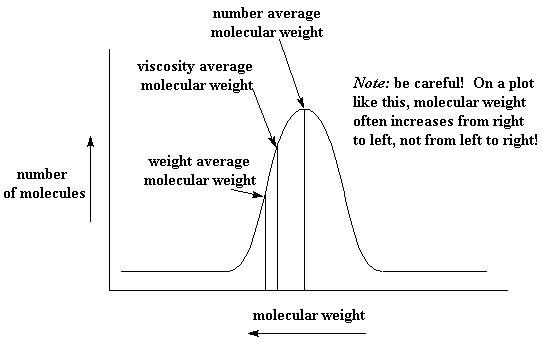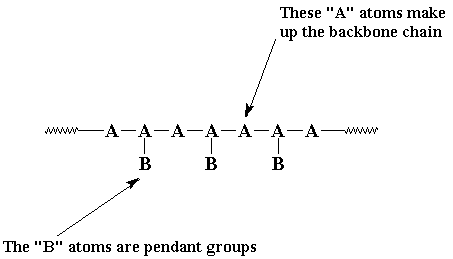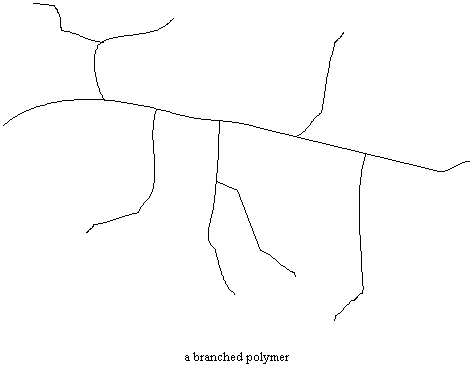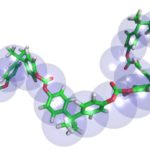This is sort of an introductory page for a more in-depth look at basic polymer composition and structure. Some of the material here was covered in the “Definitions” lesson so it might be worthwhile reviewing that. Or you can check there if you run across a word that just doesn’t make sense somehow, and of course, there’s always the “Glossary” section at the end of this course.
The first issue to get out of the way is this: when we speak of polymers, just what exactly are we talking about? What is a polymer and what isn’t? Normally the word “polymer” is used when talking about molecules whose molecular weight (or size) is in the range of several thousand and up. More or less. Pretty simple, huh? Sure, but as people say nowadays, “It’s complicated.” While it sounds simple, polymers are, in fact, very different from smaller molecules in lots of ways.
For example, in a given sample of most any polymer, the chains (polymer molecules) can vary in length. That is, there’s a range of lengths in the sample, with some chains longer than the average length and some chains shorter. In fact, it looks like the classic “Bell Curve” in many cases (figure below), where here the X-axis represents the size or length of the chains and the Y-axis represents how many chains there are for each length. Don’t worry about the various labels given for different types of molecular weights; we’ll get to all that in the next course. The thing to remember is this: polymers are almost always mixtures of chains of varying lengths.

Get in line!
Back to what we mean when we use the word “polymer.” Most of the time when we talk of polymers we’re talking about molecules with molecular weights of hundreds of thousands, or even millions. We’re also usually talking about linear polymers.

A linear polymer is a polymer molecule in which the atoms are more or less arranged in a long chain. This chain is called the backbone. Normally, some of these atoms in the chain will have small chains of atoms attached to them. These small chains are called pendant groups. The chains of pendant groups are much smaller than the backbone chain. Pendant chains normally have just a few atoms, but the backbone chain usually has hundreds of thousands, even millions of atoms.
Polymers Are Like TV: Both Have Lots and Lots of Repeats
Normally, too, when we talk of polymers, we’re not just talking about huge molecules whose atoms are arranged in chains. We like to think that the atoms that make up the backbone of a polymer chain come in a regular order, and this order repeats itself all along the length of the polymer chain. For example, in polypropylene (below),the backbone chain is made up of just two carbon atoms repeated over and over again. One carbon atom has two hydrogen atoms attached to it, and the other has one hydrogen atom and one pendant methyl group.

This unit of a carbon atom with two hydrogen atoms followed by a carbon atom with a hydrogen atom and a methyl group repeats itself over and over again along the backbone chain. This little recurring structure is called the repeat structure or the repeat unit:

To make things simple, we usually only draw one unit of the repeat structure, like that below, and pretend that’s the whole polymer. The repeat unit is put inside brackets, and the subscript n just stands for the number of repeat units in the polymer chain. The “n” usually is just a general way of saying “a huge number” although sometimes it can represent an average of some kind (more later) or even an exact number, although that’s pretty rare.

Some Assembly Required
As you’ve gathered by now, polymers don’t start out big, just like that humongous Great Dane you now own didn’t start out that size. Polymers all start as tiny molecules called monomers, a word you’ve heard many times already. We could have called those small molecules “puppies” but some animal protection organization would probably got onto us then.
So to make a polymer, a whole mess of monomers are strung together through chemical bonds to form a long polymer chain. For example, styrene monomers are joined together to make linear polystyrene (below). The chemical transformations involved will be discussed in detail in the “Basics” course, but for now, just know that this process is not only possible, it sometimes occurs explosively!

Breaking the Line
Most commercial polymers are linear the way we’ve discussed above. But it turns out, through the wonders of modern chemistry, they can come in other structures as well. For example, many polymers are branched, meaning they have structures that mimic the way tree branches come off the main trunk or other branches on that trunk. Sometimes the branching is a result of the polymerization method used and sometimes it is done on purpose with an added “branching agent” of some kind. Here’s a representation below of a branched polymer. Don’t be fooled by how simple the drawing is. A branched polymer like this can be anywhere from a few hundred monomer units to several million. Huzzah!
One thing to point out is that such branching means the chains can't get very close to each other in the solid state. By that we mean they can't "crystallize" easily, at least not to the extent purely linear polymer chains can. So why not take a short quiz just to see how you're doing? Click here.

There are dozens of other types of architectures to polymer molecular structures. To name a few: dendrimers, stars, cyclics and even weird ones like “hairy worm” structures. Let’s look at a few of these in more detail.
Network is not just a Verb
The mechanisms that lead to branch chains can have some strange habits. Sometimes, both ends of the branch chains are attached to the backbone chains of separate polymer molecules. Such a connecting chain is called a crosslink. If enough branch chains are attached to all the pairs of polymer molecules, it can happen that all of the polymer backbone chains in a sample will be attached to each other in one giant network! When this happens, the sample is in fact one single molecule, a molecule large enough to pick up in your hands! A car tire is one example of such a single molecule crosslinked polymer. A bowling ball contains only one molecule, too. Remember those old fashioned black rotary telephones? You got it, the housing is made of one molecule! The key here is the definition of a “molecule,” which is simply a collection of atoms all joined together through chemical bonds. Notice that this definition doesn’t say anything about the overall molecular structure or architecture of the atom assembly, just that you have to be able to trace a continuous line of chemical bonds to every atom throughout the molecule. Weird, when you think about it.

Star Light, Star Bright…
Sometimes the ends of several polymer chains are joined together at a common center or core. That is, the “arms” are much longer than the connecting core is across, so that the overall structure looks like a star fish. Oddly enough, polymers like this are called star polymers. You might think such weird structures would have no commercial use. Wrong! They’re actually used as additives in motor oil where their architecture causes the fluid they're in to not vary very much with temperature. This is useful to keep the viscosity (liquid “thickness”) pretty much the same over the broad temperature ranges that motor oil experiences inside your car motor.

Plant a Molecular Tree
Sometimes there is nothing that looks like a linear backbone chain at all. Sometimes a polymer is built in such a way that branches just keep growing out of branches and more branches grow out of those branches. These are called dendrimers, from the ancient Greek word for “tree”. Another name for such structures is “arborals,” again relating it to a tree-like form.

Dendrimers have unusual shapes that make pretty pictures, and they also have really unusual properties. Drug delivery is one possible use for dendrimers. Another is a silicon-based dendrimer that can trap oxygen molecules in its branches, making it a candidate for artificial blood. Other possible uses of dendrimers might be as additives in coatings to deliver active agents such as antioxidants or antibacterials. They may also be used to complex metal catalysts for use in organic synthesis or polymerizations.
Summing Up
We’ve now extended the four analogies described in the previous lesson so that we now have a more complete molecular picture of both what polymers chains look like and how they behave. Again, one causes the other. The extreme length of a linear polymer chain relative to its width results in some kinds of molecular behavior that cause physical properties and behavior. Now we’ve seen how the architecture of polymer chains provides different kinds of behavior and properties.
The Consequences of Being Big
Let’s get back to those simple linear polymers now. These giant chain-like molecules, because they are so big and because of their shape, act in ways which small molecules don’t. There are three main consequences of their “bigness,” some of which took us a long time to figure out and figure out what they mean. To find out what they are, take a look at the next lesson. For now, though, it’s time for another (you guessed it!) quiz! Click here for your next evaluation quiz. It's a long one, covering more than what we've discussed in this course so far. But hey, that's a good way to learn other than by just reading a bunch of words on a page.
And when you're ready, move on to the unique properties and behavior of polymers that result directly from the molecular level compositions: Polymer Properties.
